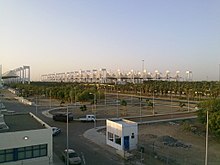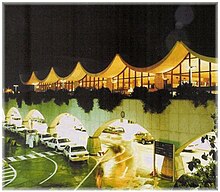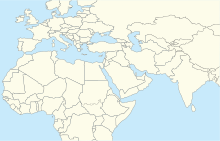King Abdulaziz International Airport[a] (IATA: JED, ICAO: OEJN, colloquially referred to as Jeddah Airport, Jeddah International Airport, or KAIA), is a major international airport serving the cities of Jeddah and Mecca in Saudi Arabia, located 19 kilometres (12 mi) north of Jeddah and covering an area of 105 square kilometres (41 sq mi). The airport is the busiest in the kingdom and the third-largest by land area. Opened in 1981, it was built to replace the now-demolished Kandara Airport and is named after the founder of Saudi Arabia, King Abdulaziz.
King Abdulaziz International Airport مطار الملك عبدالعزيز الدولي Mataar Al-Malik Abdulaziz Al-Duwaly | |||||||||||||||||||
|---|---|---|---|---|---|---|---|---|---|---|---|---|---|---|---|---|---|---|---|
 | |||||||||||||||||||
 | |||||||||||||||||||
| Summary | |||||||||||||||||||
| Airport type | Public | ||||||||||||||||||
| Owner/Operator | Jeddah Airports Company | ||||||||||||||||||
| Serves | Jeddah and Mecca, Saudi Arabia | ||||||||||||||||||
| Location | Jeddah, Saudi Arabia | ||||||||||||||||||
| Opened | 1981 | ||||||||||||||||||
| Hub for | |||||||||||||||||||
| Elevation AMSL | 15 m / 48 ft | ||||||||||||||||||
| Coordinates | 21°40′46″N 039°09′24″E / 21.67944°N 39.15667°E | ||||||||||||||||||
| Website | jed-airport | ||||||||||||||||||
| Maps | |||||||||||||||||||
 | |||||||||||||||||||
| Runways | |||||||||||||||||||
| |||||||||||||||||||
| Statistics (2023) | |||||||||||||||||||
| |||||||||||||||||||
The airport shares its airfield with the RSAF King Abdullah Air Base, and has a royal terminal and three operational passenger terminals, including a Hajj Terminal built exclusively to handle increased traffic during the Islamic Hajj pilgrimage season. It serves as the largest hub for Saudia, the Saudi flag carrier, and as an operating base for national low-cost carriers Flynas and Flyadeal.[3]
History
Before the construction of the King Abdulaziz International Airport, Jeddah and the surrounding region were served by the Kandara Airport located in the southern part of the city. Following a meeting between King Abdulaziz and Franklin D. Roosevelt in 1945, the kingdom was gifted a Douglas DC-3 that was operated between the cities of Jeddah, Riyadh, and Dhahran. In 1946, Saudia, the Saudi flag carrier, was set up and operated out of the airport. The company began flying in Hajj pilgrims to the city, first from Lod in Mandatory Palestine, and later from other countries. Construction work began in 1974 and was finalized in 1980, before the airport opened for service on May 31, 1981, having been inaugurated a month earlier.[3] Following construction of the King Abdulaziz International Airport, the Kandara Airport was demolished.[4]
Terminals




South Terminal
Opened in 1981, the South Terminal was one of the first passenger terminals at the airport, and was initially exclusively used by the national flag carrier, Saudia. The architectural design of the building was modeled on Dulles International Airport in the American capital, Washington, D.C., and incorporated tent-like structures. The terminal building consisted of separate departure and arrival lounges, and gates equipped with jet bridges. In 2007, Saudi low-cost carriers Flynas and Sama were also given permission to use the South Terminal, and later, permission to use the terminal was extended to the Indonesian flag carrier, Garuda Indonesia, and another Saudi low-cost airline, Flyadeal. After 40 years of service, on June 26, 2020, it was announced via the airport's official Twitter account that the South Terminal would be closed and its operations would be transferred to the newly-built Terminal 1.[5][6]
North Terminal
The North Terminal at King Abdulaziz International Airport is mainly used by non-Saudi airlines.
Hajj Terminal
Because of Jeddah's proximity to the city of Mecca, the airport has a dedicated Hajj Terminal built to handle pilgrims taking part in the annual Islamic Hajj pilgrimage. The Hajj Terminal can accommodate 80,000 travelers at any given time. The terminal building was designed by Bangladeshi-American architect Fazlur Rahman Khan of Skidmore, Owings & Merrill, and is known for its tent-like roof structure, engineered by Horst Berger of Geiger Berger Associates.[7] The roof is composed of ten modules, each consisting of twenty-one white tent-like Teflon-coated fiberglass structures suspended from pylons. The modules are grouped together into two blocks of five modules each, separated by a landscaped mall between the blocks.[8][9]
Only customs, baggage handling and similar facilities are located in the air-conditioned building. The vast majority of the complex is a flexible, open area called the Terminal Support Area, which is conceived to function like a village, even consisting of a souk and mosque. Not enclosed by walls, this area is sheltered from the intense sun while allowing for natural ventilation; because of this, some consider it to be a green, environmentally-friendly building. The Hajj Terminal received the Aga Khan Award for Architecture in 1983.[8][9]
Terminal 1
As part of the 2006 development project, a new passenger terminal was constructed. At 810,000 m2 (8,700,000 sq ft), it is one of the largest airport terminals in the world and can handle 30 million passengers annually.[10] Still referred to as the New Terminal, it underwent a soft opening with a domestic flight landing from Gurayat in May 2018. In March 2019, all of Saudia's domestic operations were transferred to operate from the new terminal.[11] In August 2019, Saudia started moving international operations to the new terminal,[12] and in September of that year, the new terminal was officially named Terminal 1 and inaugurated by King Salman.[13] On November 18, 2019, Etihad became the first non-Saudi airline to move to the new facility.[14]
New facilities at Terminal 1 include new lounges, a 18,000 m2 (190,000 sq ft) central garden, a 14-metre (46 ft) tall aquarium that is 10 metres (33 ft) in diameter, a mosque with a capacity of 3,732 worshippers, and a transport center that links the terminal building to the parking area and the Airport–Jeddah station of the Haramain High Speed Railway.[15] It is eventually planned to handle 80 million passengers per year.
Development projects
A development project for the airport started in 2006. The plan included the construction of Terminal 1 and the tallest air traffic control tower in the world at 136 metres (446 ft), airfield hard-standing and paved areas, lighting, fuel network systems, electronic passenger guidance systems and a new storm water drainage network. The development project also includes newly constructed support services building and upgrades to the existing runway and airfield systems.[16]
Other facilities
The General Authority of Civil Aviation maintains its presence at the Building 364, the GACA Hangar.[17] An automated people mover (APM), constructed by Alstom, exists to move passengers between Terminal 1 and the North Terminal.
The Royal Saudi Air Force maintains its presence at the King Abdullah Air Base located towards the north of the airport. The Number 4, Number 16, and Number 20 squadrons of the 8th Wing of the RSAF, operating Lockheed C-130 Hercules aircraft, use it as their home base.[18]
Haramain High Speed Railway station
Terminal 1 is connected to the Haramain High Speed Railway mainline via a 3.75-kilometre (2.33 mi) branch line. The station at the airport terminal building was named Airport–Jeddah station to distinguish it from the Al-Sulimaniyah–Jeddah station situated closer to downtown Jeddah. It provides regular connections to the Islamic holy cities of Mecca and Medina, and to the King Abdullah Economic City.[19]
Runways
The airport is served by three parallel runways designated 16L/34R, 16C/34C, and 16R/34L.
Airlines and destinations
Passenger
Cargo
Accidents and incidents
- In November 1979, Pakistan International Airlines Flight 740, a Boeing 707, crashed soon after takeoff when a fire started on board. There were no survivors.
- In 1986, a group of Iranian pilgrims were caught with C4 explosives in their bag. The explosives were put there by Iranian authorities; they wanted the explosives to go off killing many people. The pilgrims claimed that they didn't know anything about the explosives.[132]
- On 6 February 1991, a United States Air Force Boeing KC-135 Stratotanker made an emergency landing at the base after two of the KC-135's four engines ripped off, two tires burst during the landing.
- On 11 July 1991, Nigeria Airways Flight 2120, a Douglas DC-8-61, suffered cabin pressure problems followed by a fire due to a failed landing gear. The pilots tried to return to the airport but failed to reach it and the plane crashed, killing all 247 passengers and 14 crew.[133]
- On 1 March 2004, PIA Flight 2002, an Airbus A300B4-200, burst two tires whilst taking off. Fragments of the tire were ingested by the engines, causing the engines to catch fire and takeoff was aborted. Substantial damage to the engine and the left wing caused the aircraft to be written off. All 261 passengers and 12 crew survived.[134]
- In July 2015, a Saudi Arabian Airlines plane was taxing to the terminal when it crashed into an airport vehicle. [135]
Statistics
See also
Notes
References
External links
 Media related to King Abdulaziz International Airport at Wikimedia Commons
Media related to King Abdulaziz International Airport at Wikimedia Commons
- Official website

- Information on the GACA website for the King Abdulaziz Int. Airport Development Project (KADP)
- Airport information for OEJN at Great Circle Mapper. Source: DAFIF (effective October 2006).
- Current weather for OEJN at NOAA/NWS
- Accident history for JED at Aviation Safety Network
![]() This article incorporates public domain material from the Air Force Historical Research Agency
This article incorporates public domain material from the Air Force Historical Research Agency




